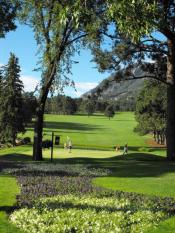The Colorado Golf Carbon Project, an initiative designed in part to recognize the ecological value of golf courses and to fund golf-related environmental research, is one of the first large-scale efforts of its kind, but if its backers have their way, it certainly won’t be the last.
The project, which got rolling late in 2009, recently received a boost — both financially and in spirit — when the USGA contributed $10,000 to the cause. The USGA became the first purchaser of a certificate for 1,000 metric tons of carbon dioxide, representing an amount of the greenhouse gas removed from the atmosphere and stored in the soil by turfgrass at one of the participating Colorado golf courses — in this case the Broadmoor in Colorado Springs.
The Broadmoor (pictured), one of the first courses to participate in the Carbon Project, will host a USGA flagship event, the U.S. Women’s Open, in July of 2011.
“Anytime you have the USGA’s (backing), it lends a lot of credibility to the project,” said Fred Dickman, director of golf course maintenance at the Broadmoor. “And all of the (major golf organizations in the state) are behind it. But the USGA has been No. 1 in supporting the agronomic side of golf. We wouldn’t be where we are today without the USGA.”
One of the purposes of the Carbon Project — which was established by the Colorado allied golf associations, including the CGA and CWGA, along with the Florida-based Golfpreserves organization — is to demonstrate the ecological value of the carbon dioxide that golf course turfgrass and perennial plantlife absorbs and then stores in the soil. The Carbon Project has other goals as well, including quantifying the “carbon footprint” of golf courses, and using the sale of carbon certificates to fund golf-related environmental research.
The project “confirms the ecosystem value of carbon sequestration, funds the research efforts to determine the storage and release of carbon dioxide by golf courses, and demonstrates the good effort of golf courses to take care of their environment,” Michael Kenna, director of USGA Green Section Research, wrote in a document on the Golfpreserves.com web site that explains the USGA participation in the Colorado Golf Carbon Project. “It is the hope of the USGA that this ($10,000 carbon certificate) purchase will lead and facilitate others throughout the golf world to do the same.”
Two-thirds of the money that goes into purchasing carbon certificates eventually will be presented to the Colorado State University Turfgrass program and the U.S. Department of Agriculture’s Research Service for further research about carbon sequestration and carbon emissions at golf courses, and the impact on the environment.
Currently, more than 20 golf courses in Colorado have taken part in the Colorado Golf Carbon Project by responding to surveys regarding their carbon footprint.
“But we’ll probably redo the survey since we got a late start last year,” said Joe McCleary, superintendent at Saddle Rock Golf Course in Aurora and a key player in the Carbon Project. “Courses were already into the season and some didn’t have time to work on the survey. If we get it reformatted and get it out earlier (in 2011), hopefully we can have more courses participate. My goal would be to get at least 20 percent of (Colorado courses) to participate so the results are statistically significant.”
Once a large amount of surveys are collected and some follow-up work is done, the plan is to publish the project’s findings about the carbon footprint of Colorado courses. But that part of the project is probably more than a year away. McCleary sees the project probably lasting three years, which would mean it would continue through 2012.
It’s clear that some of the national organizations supporting this project are looking for it to spread well beyond Colorado.
“The ultimate objective is a national rollout to other regions of the country,” said Bill Crispin, co-founder of Golfpreserves. “Colorado is the leader in this — it’s the perfect place to start — but this is just the beginning of a national effort.”
Among the reasons Colorado is at the forefront of this movement is that the CSU Turfgrass program and the U.S. Department of Agriculture have already done considerable research about carbon sequestration via turfgrass, and that Colorado-based organizations have previously conducted economic-impact and water-use studies regarding Colorado golf, and the Carbon Project is viewed as an extension of those information-gathering efforts.
The USGA sees the Colorado Golf Carbon Project as “an effort to recognize the ecosystem value of golf courses, to create a program that told this good story about golf to the world, and to develop a funding mechanism for environmental research,” according to Kenna’s article on Golfpreserves.com.
Kenna noted that 16 participating Colorado golf courses have assigned the sequestered carbon from more than 2,000 acres of turfgrass to the project. With an estimated 15,000 metric tons stored on this acreage, the USGA purchased its carbon certificate, hoping to have other organizations follow suit.
“This (project) shows how a golf course can be an asset to the environment,” Dickman said.


